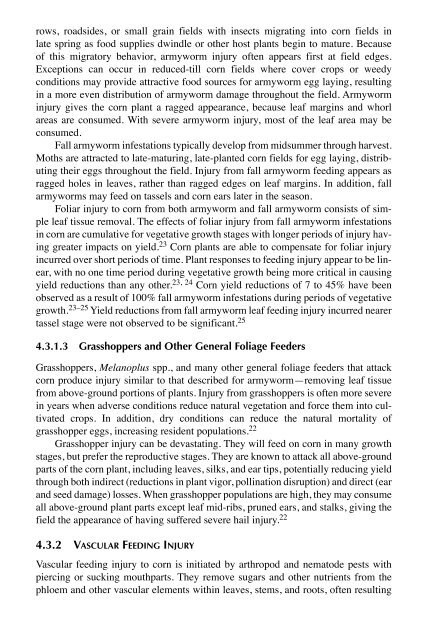Biotic Stress and Yield Loss
Biotic Stress and Yield Loss
Biotic Stress and Yield Loss
- No tags were found...
Create successful ePaper yourself
Turn your PDF publications into a flip-book with our unique Google optimized e-Paper software.
ows, roadsides, or small grain fields with insects migrating into corn fields inlate spring as food supplies dwindle or other host plants begin to mature. Becauseof this migratory behavior, armyworm injury often appears first at field edges.Exceptions can occur in reduced-till corn fields where cover crops or weedyconditions may provide attractive food sources for armyworm egg laying, resultingin a more even distribution of armyworm damage throughout the field. Armyworminjury gives the corn plant a ragged appearance, because leaf margins <strong>and</strong> whorlareas are consumed. With severe armyworm injury, most of the leaf area may beconsumed.Fall armyworm infestations typically develop from midsummer through harvest.Moths are attracted to late-maturing, late-planted corn fields for egg laying, distributingtheir eggs throughout the field. Injury from fall armyworm feeding appears asragged holes in leaves, rather than ragged edges on leaf margins. In addition, fallarmyworms may feed on tassels <strong>and</strong> corn ears later in the season.Foliar injury to corn from both armyworm <strong>and</strong> fall armyworm consists of simpleleaf tissue removal. The effects of foliar injury from fall armyworm infestationsin corn are cumulative for vegetative growth stages with longer periods of injury havinggreater impacts on yield. 23 Corn plants are able to compensate for foliar injuryincurred over short periods of time. Plant responses to feeding injury appear to be linear,with no one time period during vegetative growth being more critical in causingyield reductions than any other. 23, 24 Corn yield reductions of 7 to 45% have beenobserved as a result of 100% fall armyworm infestations during periods of vegetativegrowth. 23–25 <strong>Yield</strong> reductions from fall armyworm leaf feeding injury incurred nearertassel stage were not observed to be significant. 254.3.1.3 Grasshoppers <strong>and</strong> Other General Foliage FeedersGrasshoppers, Melanoplus spp., <strong>and</strong> many other general foliage feeders that attackcorn produce injury similar to that described for armyworm—removing leaf tissuefrom above-ground portions of plants. Injury from grasshoppers is often more severein years when adverse conditions reduce natural vegetation <strong>and</strong> force them into cultivatedcrops. In addition, dry conditions can reduce the natural mortality ofgrasshopper eggs, increasing resident populations. 22Grasshopper injury can be devastating. They will feed on corn in many growthstages, but prefer the reproductive stages. They are known to attack all above-groundparts of the corn plant, including leaves, silks, <strong>and</strong> ear tips, potentially reducing yieldthrough both indirect (reductions in plant vigor, pollination disruption) <strong>and</strong> direct (ear<strong>and</strong> seed damage) losses. When grasshopper populations are high, they may consumeall above-ground plant parts except leaf mid-ribs, pruned ears, <strong>and</strong> stalks, giving thefield the appearance of having suffered severe hail injury. 224.3.2 VASCULAR FEEDING INJURYVascular feeding injury to corn is initiated by arthropod <strong>and</strong> nematode pests withpiercing or sucking mouthparts. They remove sugars <strong>and</strong> other nutrients from thephloem <strong>and</strong> other vascular elements within leaves, stems, <strong>and</strong> roots, often resulting

















